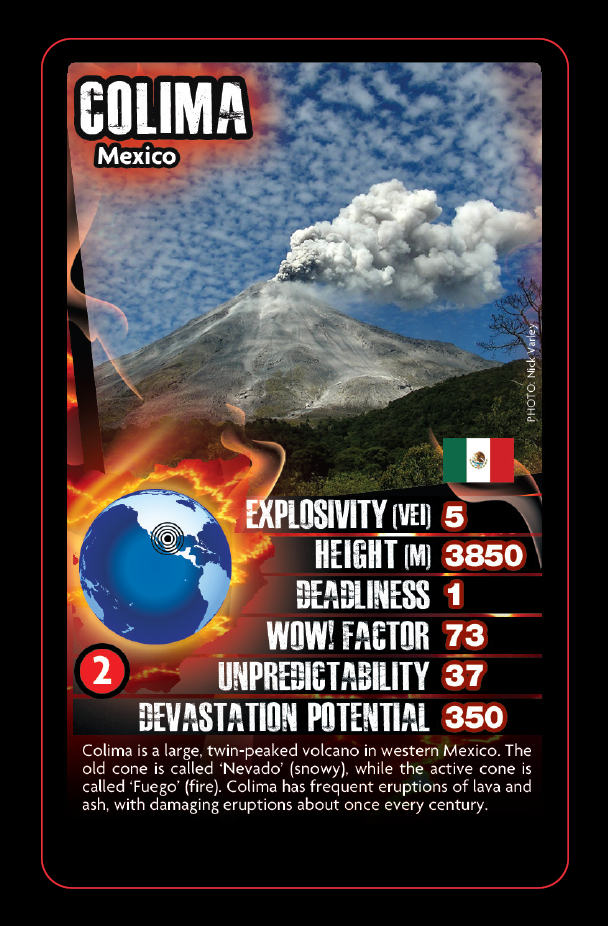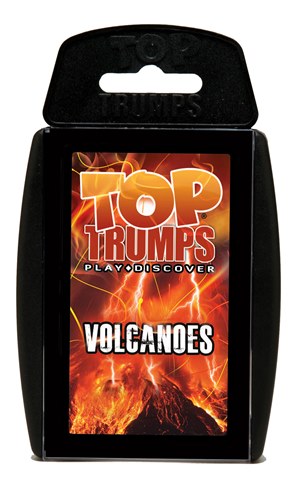 Have you ever wondered what would happen if one of those really ‘good’ ideas you have in the pub actually ended up becoming reality? That is what happened with Volcanoes Top Trumps, reports Jenni Barclay*
Have you ever wondered what would happen if one of those really ‘good’ ideas you have in the pub actually ended up becoming reality? That is what happened with Volcanoes Top Trumps, reports Jenni Barclay*
An animated conversation about how great it would be turned into an enthusiastic letter to Top Trumps Towers (yes, really!) which turned into a phone call, which turned into a visit and ….. eventually….. the full blown card game.
The idea was to create a fun and educational game, designed by experts that would generate ‘profits.’ These profits aren’t for us, but money to plough back into more science communication projects aimed at those directly impacted by volcanic activity. The team behind the game are part of a large interdisciplinary research project called STREVA (Strengthening Resilience in Volcanic Areas). The central goal of STREVA is to reduce the negative consequences of volcanic activity on people and their assets, so we wanted to create a fund that would be true to those aims.
We had the idea in October 2011, and the pack of cards went on sale on the 1st of November 2013. Now, we are finally in a position to launch a ‘competition’ for projects to use those profits to fund exciting new ideas to improve knowledge about volcanic activity for those who live alongside volcanoes.
Like all the best things in life it has been ‘a journey’, starting with the fun arguments about which 30 volcanoes and what categories to choose (a mix of tectonic environments, roughly representative of global volcano distribution if you must know) and ending with us taxing our limited sales skills at a variety of events up and down the country.
Our friends at Top Trumps Towers provided a guiding hand whenever we threatened to get too ‘nerdy’ with the categories (which didn’t work out for them with Wow! Factor which we settled via the use of a paired comparison analysis after no-one could agree) and we tried to restrict ourselves to numbers that would not get too out of date too quickly. A brilliant aspect of the cards was the enthusiastic donation of superb photos by the worldwide volcanophile community; researchers, professionals and enthusiasts alike. Their names are on the cards!
One of the ideas that originally tickled our fancy was developing the game as an app. This materialized as an online version of the game which has some fun variants (take a look: https://volcanoestoptrumps.org/game/). As well as the original packs we had to sell directly, Top Trumps now also sell the packs more widely, and we receive a Royalty for each of these packs sold. Through Top Trumps the packs are now available in Europe, North America and Australasia. It is quite a thrill seeing the packs for sale in random shops, although we have to resist the temptation to stand around pointing and whispering ‘I invented these’ to random passersby. We’ve heard reports of people playing the game on volcanoes around the world and even in school on the world’s most remote island, Tristan da Cunha.
Photo by Anna Hicks. Working with Communities on St. Vincent. 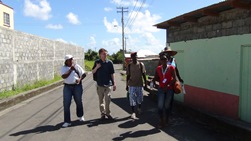
Probably the most exciting phase of this project is yet to come, however - seeing some interesting projects take place using our funds that might otherwise never happened. We have started the ball rolling with a pilot project in the region where STREVA is working: a community project on the slopes of Cotopaxi (Ecuador) which was designed to get school children talking to their elders about memories of past volcanic activity. The children’s notes and drawings will be made into a book and sold to tourists to raise funds for equipment for their school. And that is what it was all about in the first place!
Now we would like to invite entries for similar ideas from the wider community. In the first instance we will be awarding three project prizes of up to £1000 for projects that capture the spirit of what works well in volcanic risk reduction projects, based on STREVA and other project’s research.
Simply put, these should be collaborative, inclusive and imaginative. A link to enter the competition can be found here: https://volcanoestoptrumps.org/vtt-community-competition/. The closing date is 15 August 2016.
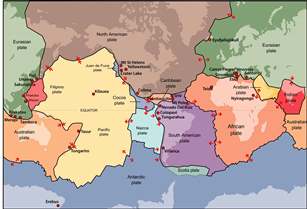 Image: Plate tectonic plates and the global distribution of the Top Trumps Volcanoes.
Image: Plate tectonic plates and the global distribution of the Top Trumps Volcanoes.
About the Volcanoes Top Trumps Categories
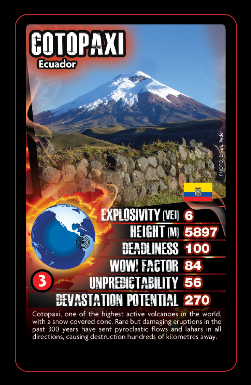 We have 6 categories: Height (m); Unpredictability; Wow! Factor, Deadliness, Explosivity and Devastation Potential. All are based on the real data from each volcano: we tried to blend keeping the game fun with learning something new and exciting about volcanoes.
We have 6 categories: Height (m); Unpredictability; Wow! Factor, Deadliness, Explosivity and Devastation Potential. All are based on the real data from each volcano: we tried to blend keeping the game fun with learning something new and exciting about volcanoes.
Here is a summary:
- Height. Height in metres above sea level (Between 0 and 5897). This presented an interesting dilemma: do we take the measurement from sea level to the summit. or, in the case of volcanoes which are also islands, should we measure the height all the way from the sea floor? Ocean island volcanoes begin their lives as submarine volcanoes and eventually emerge from the sea and continue to grow by eruption. This means their true height could be much larger than those of continental volcanoes. Mauna Kea, in Hawaii for example rises 4,205 metres above sea level, but 10,200 metres from its ocean base to its summit – that’s nearly 2 kilometres taller than Mount Everest! To keep it simple, our statistics are actual heights, in metres above sea level, taken from the Smithsonian Global Institution Global Volcanism Program.
- Explosivity: This is the maximum recorded eruptive size measured using the Volcanic Explosivity Index (VEI). This measures several things: how high the shattered volcanic material is thrown into the air, how much material is erupted and how quickly it comes out. The VEI scale goes from 0 to 8, but it is designed so that a change in the scale by 1 is an order of magnitude change in eruption size. In very simple terms, a VEI 1 eruption throws out about enough material to fill a large football stadium (about 1 million cubic metres of ash), while a VEI 8 eruption throws out enough material to bury the whole of the United States with 10 cm of ash (about 1000 cubic kilometres of ash).
- Unpredictability: An index created from the range and frequency of different sizes of activity at that volcano (0 to 100). A big challenge for volcanologists is being able to predict when a volcano is going to erupt, what it is going to do when it erupts, and how long it will be before it stops again. All of these factors contribute to a volcano’s unpredictability.
No two volcanoes are completely alike. They can vary in the size and style of their eruptions. Some eruptions can go on for days, months or even years. Some can be over in a matter of minutes. Even at the same volcano, no two eruptions are completely alike. You can find a useful description of the different kinds of eruption at volcano world. Nonetheless, some volcanoes (like Yasur) erupt in pretty much the same way each time, and some can have a much bigger variation between eruptions (like Vesuvius). In our unpredictability category, we wanted to explore this.
We used the Smithsonian Institution Global Volcanism Program Eruptive Record calculate the average size (VEI) of eruptions, and multiplied it by the range of that number. We also factored in the number of eruptions that it has had. This way, a volcano that has had a lot of eruptions all of the same size will have a low unpredictability, while a volcano that is less well known and may have had both large and small eruptions will have a high unpredictability.
- Wow! Factor: An index that reflects the relative amount the volcano makes the VTT Team go Wow!(*) ( 0 to 100). Because we could not agree to do this we tried to use it as a demonstration of how scientists sometimes try to approach something that is hard to quantify. We can’t measure prettiness, impressiveness, or pointiness, but those are the types of things we think of when considering how much a volcano makes you go ‘wow’.
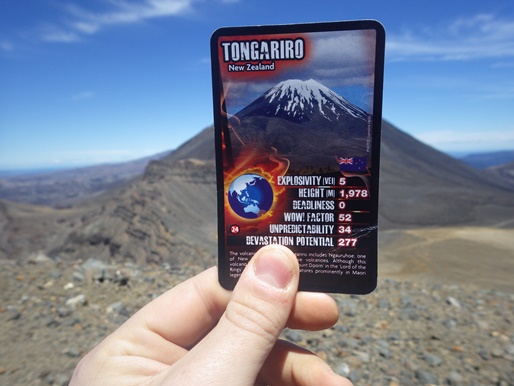 By using our impressions of features such as size, accessibility and whether the volcano is actually erupting, we ranked the volcanoes using a method known as paired comparison. Some of us ranked certain volcanoes higher than others, but by combining all of our rankings we created a ‘consensus’ of opinion. We then converted these rankings in to a score, that ranged somewhere from 20 to 100, so that the higher the number, the more ‘Wow!’ the expert group thought it was. This way, we have tried to make a very subjective category as objective as possible!
By using our impressions of features such as size, accessibility and whether the volcano is actually erupting, we ranked the volcanoes using a method known as paired comparison. Some of us ranked certain volcanoes higher than others, but by combining all of our rankings we created a ‘consensus’ of opinion. We then converted these rankings in to a score, that ranged somewhere from 20 to 100, so that the higher the number, the more ‘Wow!’ the expert group thought it was. This way, we have tried to make a very subjective category as objective as possible!
- Deadliness: An index made from the recorded deaths as a direct result of that volcano’s activity ( 0 to 1000). This is an index that shows the relative number of people who have been killed directly by that volcano and recorded in the Global Volcanism Catatlogue of the Smithsonian Institution. This might seem to be an inappropriate category to include in a fun game but it is a reminder that there is a serious side to all this. Volcanoes are dangerous and one of the goals of research projects like STREVA is to reduce loss of life in volcanic eruptions.
- Devastation Potential: An index to reflect the possible havoc if a maximum eruption happened now (0 to 1000). Here at Volcano Top Trumps HQ, we wanted to come up with an exciting category that described a volcano’s potential for devastation. Some of our volcanoes, in particular the more explosive ones, haven’t erupted for a while. Other volcanoes, such as Mount Etna haven’t had really big eruptions for a while either. In the mean time, towns and cities have grown in their shadows, and countries have become more and more dependent on infrastructure (like airports, roads, water and power supplies) which could be vulnerable to volcanic hazards.
So we decided to come up with a category that tries to measure this…!
We limited ourselves to the following bits of information about a volcano, and created an equation to calculate devastation potential using the following data, which are widely available:
- The Maximum Eruption Size
- The number of people living within a certain distance, which we then rank the volcanoes by
- The number of times it has erupted at its Maximum VEI (VEICOUNT)
- We also tried to evaluate a volcano’s potential for ‘Global Impact’ (I)
Picture: Cartoon to represent 'Explosivity' by Luke Surl, University of Edinburgh
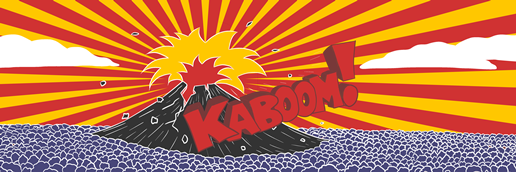 About the STREVA Project and our research
About the STREVA Project and our research
Strengthening Resilience in Volcanic Areas is a project funded by the UK Natural Environment and Economic and Social Research Councils (NERC_ESRC) with a central goal to reduce the negative impacts of volcanic activity on people and their assets. We are doing this by identifying the most important drivers of risk via detailed analysis of past or ongoing volcanic eruptions, and by considering the threats to people’s livelihoods as well as to their lives during eruptive episodes.
During our research we have found that communication is improved by involving those who directly experienced the impacts of past eruptions in the process. They often understand best the impacts of both volcanic activity and the scientific uncertainty in forecasting what happens next. We have taken care to involve them in the research process and to feedback our new understanding of the drivers of risk in each setting. Competition Winners will have to be able to demonstrate similar principles in their outlines of how they would spend the money!
STREVA is working in the Caribbean, Ecuador and Colombia on both identifying the drivers of risk and understanding eruptive behaviour with our local project partners (http://streva.ac.uk/our-outputs/researchers). We have produced films in St. Vincent and Colombia that provide documentary records of experiences of past activity. You can see them here: https://www.youtube.com/user/STREVAProject . We are currently working to understand how these films might help these communities to better prepare for a future eruption.
Finding more information about Volcanoes Top Trumps
Volcanoes Top Trumps Top Stats
- Number of packs sold: 13,000
- Hits on our website: 44,572
- Most popular volcano on web: Santiaguito
- Wow! Moment: appearing on Channel 4’s ‘Escape to the Wild’ with Kevin McCloud (Grand Designs) playing the game in front of Villarica
- No. of TopTrumps volcanoes which have erupted since launch: 15
* Jenni Barclay University of East Anglia E: [email protected]. The Volcanoes Top Trumps team are six geoscientists dedicated to engaging as many people on anything and everything to do with volcanoes: Jenni Barclay (University of East Anglia); Anna Hicks (British Geological Survey); Jonathan Stone (Tearfund); Paul Cole and Iain Stewart (University of Plymouth); David Pyle (University of Oxford).
